Ancient Macedonian army
| Ancient Macedonian army | |
|---|---|
| Participant in Rise of Macedon, Alexander's Balkan campaign, the Wars of Alexander the Great | |
|
Hypaspist in light equipment (modern reconstruction) | |
| Leaders | Philip II of Macedon, Alexander III of Macedon |
| Headquarters | Pella, Babylon |
| Area of operations | Greece, Balkans, Anatolia, Syria, Phoenicia, Egypt, Mesopotamia, Iran, India |
| Strength | 32,000+ - the field army for Alexander the Great's invasion of the Persian Empire - according to Diodorus Siculus. This figure fluctuated, for example at Gaugamela, Alexander commanded at least 47,000 soldiers. |
| Part of | Kingdom of Macedon |
| Became | Armies of the Diadochi - Hellenistic armies, Antigonid Macedonian army |
| Allies | League of Corinth. |
| Opponents | Illyrians, Thracians, Phocis, Athens, Thebes, Sparta, Persian Empire, Kingdom of Porus, Scythians. |
| Battles and wars | Battle of Crocus Field, Battle of Chaeronea, Battle of Thebes, Battle of Granicus, Battle of Issus, Battle of Gaugamela, Battle of the Hydaspes |
The army of the Kingdom of Macedonia was among the greatest military forces of the ancient world. It was created and made formidable by King Philip II of Macedon; previously the army of Macedon had been of little account in the politics of the Greek world, and Macedonia had been regarded as a second-rate power.
The latest innovations in weapons and tactics were adopted and refined by Philip II, and he created a uniquely flexible and effective army. By introducing military service as a full-time occupation, Philip was able to drill his men regularly, ensuring unity and cohesion in his ranks. In a remarkably short time, this led to the creation of one of the finest military machines of the ancient world.
Tactical improvements included the latest developments in the deployment of the traditional Greek phalanx made by men such as Epaminondas of Thebes and Iphicrates of Athens. Philip II improved on these military innovators by using both Epaminondas' deeper phalanx and Iphicrates' combination of a longer spear and smaller and lighter shield. However, the Macedonian king also innovated; he introduced the use of a much longer spear, the two-handed pike. The Macedonian pike, the sarissa, gave its wielder many advantages both offensively and defensively. For the first time in Greek warfare, cavalry became a decisive arm in battle. The Macedonian army perfected the co-ordination of different troop types, an early example of combined arms tactics — the heavy infantry phalanx, skirmish infantry, archers, light and heavy cavalry, and siege engines were all deployed in battle; each troop type being used to its own particular advantage and creating a synergy of mutual support.
The new Macedonian army was an amalgamation of different forces. Macedonians and other Greeks (especially Thessalian cavalry) and a wide range of mercenaries from across the Aegean and Balkans were employed by Phillip. By 338 BC, more than a half of the army for his planned invasion of Persia came from outside the borders of Macedon — from all over the Greek world and the nearby barbarian tribes.
Unfortunately, most of the primary historical sources for this period have been lost. As a consequence, scholarship is largely reliant on the writings of Diodorus Siculus and Arrian, both of whom lived centuries later than the events they describe.[1]
Origins
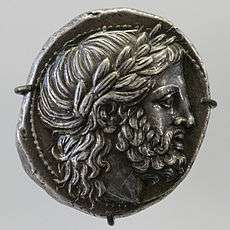
If Philip II had not been the father of Alexander the Great, he would be more widely known as a first-rate military innovator, tactician and strategist, and as a consummate politician. The conquests of Alexander would have been impossible without the army his father created. Considered semi-barbarous by some metropolitan Greeks, the Macedonians were a martial people; they drank deeply of unwatered wine (the very mark of a barbarian) and no youth was considered to be fit to sit with the men at table until he had killed, on foot with a spear, a wild boar.[2]
When Philip took over control of Macedon, it was a backward state on the fringes of the Greek world and was beset by its traditional enemies: Illyrians, Paeonians and Thracians. Recent history also furnished a number of instances of military intervention in Macedon by a number of Greek states, including Thebes and Athens. Macedon itself was not unified, it consisted of a heartland inhabited by the Macedonians proper and many highland 'baronies' peopled by tribesmen ruled by semi-hellenised chieftains, who recognised the power of the king only when it was in their interest. Previous kings of Macedon had raised armies including good quality cavalry, a small number of hoplite infantry and fairly numerous light infantry; however, these forces were not rigorously trained or organised and were only just capable of keeping Macedon intact — the kingdom often being raided or invaded by the surrounding barbarian peoples.
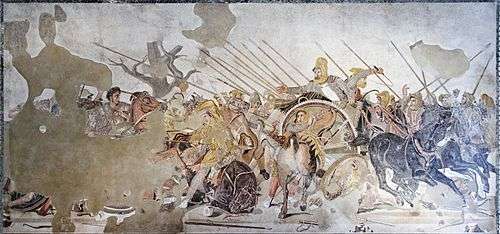
Philip's first achievement was to unify Macedon through his army. He raised troops and made his army the single fount of wealth, honour and power in the land; the unruly chieftains of Macedonia became the officers and elite cavalrymen of the army, the highland peasants became the footsoldiers. Philip took pains to keep them always under arms and either fighting or drilling. Manoeuvres and drills were made into competitive events, and the truculent Macedonians vied with each other to excel.[3] As a political counterbalance to the native-born Macedonian nobility, Philip invited military families from throughout Greece to settle on lands he had conquered or confiscated from his enemies, these 'personal clients' then also served as army officers or in the Companion cavalry. After taking control of the gold-rich mines of Mount Pangaeus, and the city of Amphipolis that dominated the region, he obtained the wealth to support a large army, moreover it was a professional army imbued with a national spirit. By the time of his death, Philip's army had pushed the Macedonian frontier into southern Illyria, conquered the Paeonians and Thracians, asserted a hegemony over Thessaly, destroyed the power of Phocis and defeated and humbled Athens and Thebes. All the states of Greece, with the exception of Sparta, Epirus and Crete, had become subservient allies of Macedon (League of Corinth) and Philip was laying the foundations of an invasion of the Persian Empire, an invasion that his son would successfully undertake.[4]
One important military innovation of Philip II is often overlooked, he banned the use of wheeled transport and limited the number of camp servants to one to every ten infantrymen and one each for the cavalry. This reform made the baggage train of the army very small for its size and improved its speed of march.[5]
Troop types and unit organisation
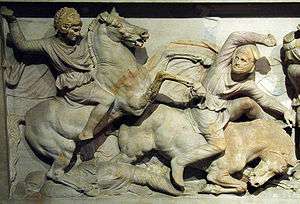
Heavy cavalry
The Companion cavalry
The Companion cavalry, or Hetairoi (Ἑταῖροι), were the elite arm of the Macedonian army, and have been regarded as the finest quality cavalry[6] in the ancient world. Along with Thessalian cavalry contingents, the Companions—raised from landed nobility—made up the bulk of the Macedonian heavy cavalry. Central Macedonia was good horse-rearing country and cavalry was prominent in Macedonian armies from early times. However, it was the reforms in organisation, drill and tactics introduced by Philip II that transformed the Companion cavalry into a battle-winning force.
The hetairoi were divided into squadrons called ilai (singular: ilē), each 200 men strong, except for the Royal Squadron, which numbered 300. The Royal Squadron was also known as the Agema - "that which leads". Each squadron was commanded by an ilarchēs (ilarch) and appears to have been raised from a particular area of Macedon. Arrian, for instance, described squadrons from Bottiaea, Amphipolis, Apollonia and Anthemus.[7] It is probable that Alexander took eight squadrons with him on his invasion of Asia totalling 1,800 men, leaving seven ilai behind in Macedon (the 1,500 cavalrymen mentioned by Diodorus).[8] Between 330 BC and 328 BC, the Companions were reformed into regiments (hipparchies) of 2-3 squadrons. In conjunction with this, each squadron was divided into two lochoi. This was probably undertaken to allow for the increase in size of each squadron, as reinforcements and amalgamations meant that the Companion cavalry grew in size. At this time, Alexander abandoned the regional organisation of the ilai, choosing their officers regardless of their origins.[9]
The individual Companion cavalry squadron was usually deployed in a wedge formation, which facilitated both manoeuvrability and the shock of the charge. The advantage of the wedge was that it offered a narrow point for piercing enemy formations and concentrated the leaders at the front. It was easier to turn than a square formation because everyone followed the leader at the apex, "like a flight of cranes". Philip II introduced the formation, probably in emulation of Thracian and Scythian cavalry, though the example of the rhomboid formation adopted by Macedon's southern neighbours, the Thessalians, must also have had some effect.[10]
The primary weapon of the Macedonian cavalry was the xyston, a double ended lance, with a sword as a secondary weapon. From descriptions of combat, it would appear that once in melee the Companion cavalryman used his lance to thrust at the chests and faces of the enemy. It is possible that the lance was aimed at the upper body of an opposing cavalryman in the expectation that a blow which did not wound or kill might have sufficient leverage to unseat. If the lance broke, the Companion could reverse it and use the other end, or draw his sword. Cleitus, an officer of the Companions, saved Alexander the Great's life at the Granicus by cutting off an enemy horseman's arm with his sword.[11] Companion cavalrymen would normally have worn armour and a helmet in battle.[12]
Although the Companion cavalry is largely regarded as the first real shock cavalry of Antiquity, it seems that Alexander was very wary of using it against well-formed infantry, as attested by Arrian in his account of the battle against the Malli, an Indian tribe he faced after Hydaspes. There, Alexander did not dare assault the dense infantry formation with his cavalry, but rather waited for his infantry to arrive, while he and his cavalry harassed their flanks.[13] It is a common mistake to portray the Companion cavalry as a force able to burst through compact infantry lines. Alexander usually launched the Companions at the enemy after a gap had opened up between their units or disorder had already disrupted their ranks. However, the ancient historian Arrian implies that the Companion cavalry were successful in an assault, along with heavy infantry, on the Greek mercenary hoplites serving Persia in the closing stages of the Battle of Granicus. Their success may have been largely due to the poor morale of the hoplites who had just witnessed the rest of their army broken and put to flight.[14]
The Companions who accompanied Alexander to Asia numbered 1,800 men. This number steadily grew as the campaign progressed, with 300 reinforcements arriving from Macedon after the first year of campaigning. They were usually arrayed on the right flank (this being the position of honour in Hellenic armies, where the best troops would be positioned), and typically carried out the decisive manoeuvre/assault of the battle under Alexander's direct leadership.[15]
Thessalian cavalry

Following the defeat of Lycophron of Pherae and Onomarchos of Phocis, Philip II of Macedon was appointed Archon of the Thessalian League; his death induced the Thessalians to attempt to throw off Macedonian hegemony, but a short bloodless campaign by Alexander restored them to allegiance. The Thessalians were considered the finest cavalry of Greece.
The Thessalian heavy cavalry accompanied Alexander during the first half of his Asian campaign and continued to be employed by the Macedonians as allies until Macedon's final demise at the hands of the Romans. Its organization and weaponry were similar to the Companion Cavalry. However, shorter spears and javelins were wielded in addition to the xyston. The Thessalian cavalry was famed for its use of rhomboid formations, said to have been developed by the Thessalian Tagos (head of the Thessalian League) Jason of Pherae. This formation was very efficient for manoeuvring, as it allowed the squadron to change direction at speed while still retaining cohesion.[16] The numbers given for Alexander's invasion of the Persian Empire included 1,800 such men. This number would have risen no higher than 2,000. They were typically entrusted with the defensive role of guarding the left flank from enemy cavalry, allowing the decisive attack to be launched on the right. They often faced tremendous opposition when in this role. At Issus and Gaugamela, the Thessalians withstood the attack of Persian cavalry forces, though greatly outnumbered.
At Ecbatana, the Thessalians with Alexander's army were mustered out and sent home. Some remained with the army as mercenaries, yet these too were sent home a year later when the army reached the Oxus River.
Other Greek cavalry
The Hellenic states allied to, or more accurately under the hegemony of, Macedon provided contingents of heavy cavalry and the Macedonian kings hired mercenaries of the same origins. Alexander had 600 Greek cavalrymen at the start of his campaign against Persia, probably organised into 5 ilai. These cavalrymen would have been equipped very similarly to the Thessalians and Companions, but they deployed in a square formation eight deep and sixteen abreast.[8] The Greek cavalry was not considered as effective or versatile as the Thessalian and Macedonian cavalry.
Light cavalry
Light cavalry, such as the Prodromoi, secured the wings of the army during battle and went on reconnaissance missions. Apart from the Prodromoi, other horsemen from subject or allied nations, filling various tactical roles and wielding a variety weapons, rounded out the cavalry. By the time Alexander campaigned in India, and subsequently, the cavalry had been drastically reformed and included thousands of horse-archers from Iranian peoples such as the Dahae (prominent at the Battle of Hydaspes), other mounted missile troops, plus Asiatic heavy cavalry.
Prodromoi
The Prodromoi, who were Macedonians, are sometimes referred to as Sarissophoroi, or "lancers", which leads to the conclusion that they sometimes were armed with an uncommonly long xyston (believed to be 14 ft long), though certainly not an infantry pike. They acted as scouts reconnoitering in front of the army when it was on the march. In battle, they were used in a shock role to protect the right flank of the Companion cavalry. Their abilities as scouts would seem to have been mediocre, because Persian light cavalry took over these duties when they became available to the Macedonian army following Gaugamela. The Prodromoi then assumed a purely battlefield role as shock cavalry. It is also possible that the Prodromoi, due to their skill in wielding long lances and their extensive battle experience, were considered more valuable in the role of shock cavalry, especially after the departure of the Thessalian cavalry. Four ilai, each 150 strong, of Prodromoi operated with Alexander's army in Asia.[17]
At Gaugamela, the Prodromoi under Aretes were responsible for finally routing the Persian left wing cavalry, winning the battle in this sector.
Paeonian cavalry
These light cavalry were recruited from Paeonia, a tribal region to the north of Macedonia. The Paeones had been conquered and reduced to tributary status by Philip II. Led by their own chieftains, the Paeonian cavalry was usually brigaded with the Prodromoi and often operated alongside them in battle. They appear to have been armed with javelins and swords. Initially, only one squadron strong, they received 500 reinforcements in Egypt and a further 600 at Susa.[18]
Thracian cavalry
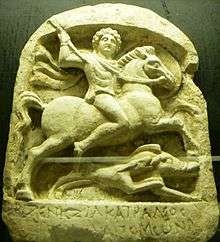
Largely recruited from the Odrysian tribe, the Thracian cavalry also acted as scouts on the march. In battle, they performed much the same function as the Prodromoi and Paeonians, except they guarded the flank of the Thessalian cavalry on the left wing of the army. The Thracians deployed in their ancestral wedge formations and were armed with javelins and swords. At Gaugamela, the Thracians fielded four ilai and were about 500 strong.[18]
Horse archers
In 329 BC, Alexander, while in Sogdiana, created a 1,000 strong unit of horse archers that was recruited from various Iranian peoples. They were very effective at scouting and in screening the rest of the army from the enemy. Firing their bows whilst mounted, they offered highly mobile missile fire on the battlefield. At the Battle of Hydaspes, the massed fire of the horse archers was effective at disordering the Indian cavalry and helped to neutralise the Indian chariots.[19]
Heavy infantry
The Foot Companions
The Macedonian foot soldiers were formed into an infantry formation developed by Philip II and used by his son Alexander the Great to conquer the Persian Empire and other enemies. These infantrymen were called Pezhetairoi — the Foot Companions — and made up the dreaded Macedonian phalanx. Diodorus Siculus wrote “indeed he devised the compact order and the equipment of the phalanx, imitating the close order fighting with overlapping shields of the warriors at Troy, and was the first to organize the Macedonian phalanx.”[20]
Philip II spent much of his youth as a hostage at Thebes, where he studied under the renowned general Epaminondas, whose reforms were the basis for a good part of Philip's tactics. However, the introduction of the sarissa pike, heavier armour and a smaller shield seem to have been innovations devised by Philip himself. Diodorus claimed that Philip was inspired to make changes in the organisation of his Macedonian infantry from reading a passage in the writings of Homer describing a close-packed formation.[21] Foot Companions were levied from the peasantry of Macedon. Once levied they became professional soldiers. Discharge could only be granted by the King. Under Philip, the Foot Companions received no regular pay. This seems to have changed by Alexander's time as during the mutiny at Opis in 324 BC, the men were chastised by Alexander for having run up debts despite earning "good pay".[22] Through extensive drilling and training, the Foot Companions were able to execute complex manoeuvres well beyond the reach of most contemporary armies. The sound of myriads of pikes moving though the air in unison, as they were deployed, was said to be most impressive, and demoralising to the ears of enemy troops.

The size of the phalanx fielded by Macedon and its various successor states varied greatly. Alexander the Great, for example, fielded 9,000 Foot Companions throughout much of his campaign. These were divided into 1,500-man battalions, each raised from a separate district of Macedon. Philip V fielded 16,000 phalangites at the Battle of Cynoscephalae, and Perseus reputedly fielded over 20,000 at Pydna.
These soldiers fought in close-ranked rectangular or square formations, of which the smallest tactical unit was the 256 men strong syntagma or speira. This formation typically fought eight or sixteen men deep and in a frontage of thirty-two or sixteen men accordingly. Each file of 16 men, a lochos, was commanded by a lochagos who was in the front rank. Junior officers, one at the rear and one in the centre, were in place to steady the ranks and maintain the cohesion of the formation, similar to modern-day NCOs. The commander of the syntagma theoretically fought at the head of the extreme far-right file. According to Aelian, a syntagma was accompanied by five additional individuals to the rear: a herald (to act as a messenger), a trumpeter (to sound out commands), an ensign (to hold the unit's standard), an additional officer (called ouragos), and a servant. This array of both audial and visual communication methods helped to make sure that even in the dust and din of battle orders could still be received and given. Six syntagmata formed a taxis of 1,500 men commanded by a strategos, six taxeis formed a phalanx under a phalangiarch.[23]
Each phalangite carried as his primary weapon a sarissa, which was a type of pike. The length of these pikes was such that they had to be wielded with two hands in battle. The traditional Greek hoplite used his spear single-handed, as the large hoplon shield needed to be gripped by the left hand, therefore the Macedonian phalangite gained in both weapon reach and in the added force of a two handed thrust. At close range, such large weapons were of little use, but an intact phalanx could easily keep its enemies at a distance; the weapons of the first five rows of men all projected beyond the front of the formation, so that there were more spearpoints than available targets at any given time. The men of the rear ranks raised their sarissas so as to provide protection from aerial missiles. A phalangite also carried a sword as a secondary weapon for close quarter fighting should the phalanx disintegrate. The phalanx, however, was extremely vulnerable in the flanks and rear.[24]
Alexander did not actually use the phalanx as the decisive arm of his battles, but instead used it to pin and demoralize the enemy while his heavy cavalry would charge selected opponents or exposed enemy unit flanks, most usually after driving the enemy horse from the field. An example of this is the Battle of Gaugamela, where, after maneuvering to the right to prevent a double envelopment from the Persian army and making Darius command his cavalry on his left flank to check the oblique movement of the Greeks by attacking their cavalry, Companion cavalry charged the weakened enemy center where Darius was posted and were followed by the hypaspists and the phalanx proper.
The phalanx carried with it a fairly minimal baggage train, with only one servant for every ten men. This gave it a marching speed that contemporary armies could not hope to match — on occasion forces surrendered to Alexander simply because they were not expecting him to show up for several more days. This was made possible thanks to the training Philip instilled in his army, which included regular forced marches.
The Macedonian phalanx itself was thus not very different from the hoplite phalanx of other Greek states as a formation. As an evolution of the hoplite phalanx, it featured improved equipment, training, and tactics. In Philip's and Alexander's time, the Macedonian phalanx had clear technical superiority.

Hypaspists
The Hypaspists (Hypaspistai) were the elite arm of the Macedonian infantry. The word 'hypaspists' translates into English as 'shield-bearers'. During a pitched battle, such as Gaugamela, they acted as guard for the right flank of the phalanx and as a flexible link between the phalanx and the Companion cavalry. They were used for a variety of irregular missions by Alexander, often in conjunction with the Agrianians (elite skirmishers), the Companions and select units of phalangites. They were prominent in accounts of Alexander's siege assaults in close proximity to Alexander himself. The Hypaspists were of privileged Macedonian blood and their senior chiliarchy formed the Agema[25] foot bodyguard of Alexander III.[26]
The Hypaspist regiment was divided into three battalions (chiliarchies) of 1,000 men, which were then further sub-divided in a manner similar to the Foot Companions. Each battalion would be commanded by a chiliarch, with the regiment as a whole under the command of an archihypaspist.
In terms of weaponry, they were probably equipped in the style of a traditional Greek hoplite with a thrusting spear or doru (shorter and less unwieldy than the sarissa) and a large round shield (hoplon).[27] As well as this, they would have carried a sword, either a xiphos or a kopis. This would have made them far better suited to engagements where formations and cohesion had broken down, making them well suited to siege assaults and special missions. Their armour appears to have varied depending on the type of mission they were conducting. When taking part in rapid forced marches or combat in broken terrain, so common in the eastern Persian Empire, it appears that they wore little more than a helmet and a cloak (exomis) so as to enhance their stamina and mobility. However, when engaging in heavy hand-to-hand fighting, for instance during a siege or pitched battle, they would have worn body armour of either linen or bronze. This variety of armaments made them an extremely versatile force. Their numbers were kept at full strength, despite casualties, by continual replenishment through the transfer of veteran soldiers chosen from the phalanx.[28]
In the last years of Alexander's reign, the Hypaspists may have been renamed to become the Argyraspides, or Silver Shields. However, some scholars believe that the Argyraspides were formed from veterans selected from the whole phalanx.
Greek hoplites

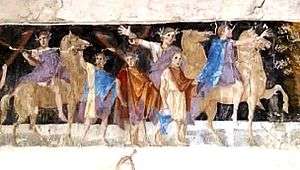
The army led by Alexander the Great into the Persian Empire included Greek heavy infantry in the form of allied contingents provided by the League of Corinth and hired mercenaries. These infantrymen would have been equipped as hoplites with the traditional hoplite panoply consisting of a thrusting spear (doru), bronze-faced hoplon shield and body armour. In appearance, they would have been almost identical to the hypaspists. In battle, the Greek hoplites had a less active role than the Macedonian phalangites and hypaspists. At Gaugamela, the Greek infantry formed the defensive rear of the box formation Alexander arranged his army into, while the Macedonians formed its front face.[29] Nevertheless, they performed a valuable function in facing down attempts by the Persian cavalry to surround the Macedonian army and helped deal with the breakthrough of some Persian horsemen who went on to attack the baggage.
Light infantry
Peltasts
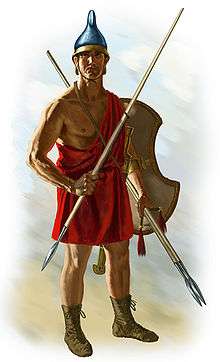
The peltasts raised from the Agrianes, a Paeonian tribe, were the elite light infantry of the Macedonian army. They were often used to cover the right flank of the army in battle, being posted to the right of the Companion cavalry, a position of considerable honour. They were almost invariably part of any force on detached duty, especially missions requiring speed of movement.[30] Other nationalities also provided peltasts for the Macedonian army. Especially numerous were the Thracians; the Thracian peltasts performed the same function in battle as the Agrianians, but for the left wing of the army.
Peltasts were armed with a number of javelins and a sword, carried a light shield but wore no armour, though they sometimes had helmets; they were adept at skirmishing and were often used to guard the flanks of more heavily equipped infantry. They usually adopted an open order when facing enemy heavy infantry. They could throw their javelins at will at the enemy and, unencumbered by armour or heavy shields, easily evade any counter-charges made by heavily equipped hoplites. They were, however, quite vulnerable to shock-capable cavalry and often operated to particular advantage on broken ground where cavalry was useless and heavy infantry found it difficult to maintain formation.[31][32]
Archers
In most Greek states, archery was not greatly esteemed, nor practised by native soldiery, and foreign archers were often employed, such as the Scythians prominent in Athenian employ. However, Crete was notable for its very effective archers, whose services as mercenaries were in great demand throughout the Greek World. Cretan archers were famed for their powerful bows, firing arrows with large, heavy heads of cast bronze. They carried their arrows in a quiver with a protective flap over its opening. Cretan archers were unusual in carrying a shield, which was relatively small and faced in bronze. The carrying of shields indicates that the Cretans also had some ability in hand-to-hand fighting, an additional factor in their popularity as mercenaries.[33] Archers were also raised from Macedonia and various Balkan peoples.
The use of Oriental soldiers under Alexander the Great
According to Arrian, Alexander used Arachosian, Bactrian, Parapamisadaean, Sogdian, Indian, and Scythian troops. They were present at the grand army revue Alexander assembled in 324 BC. The army supposedly reached 120,000 front-line troops at one point. This did not include camp followers. There has been considerable debate as to when Alexander first used Orientals in the army.[34] The introduction of orientals into the army was actively resented by many of the native Macedonians, especially when a cadre of young Persians from aristocratic families was trained in Macedonian fighting techniques and enrolled in the Companion Cavalry.[35]
Arms and armour
Weapons
Most troops would have carried a type of sword as a secondary weapon. The straight-bladed shortsword known as the xiphos (ξίφος) is depicted in works of art, and two types of single-edged cutting swords, the kopis and machaira, are shown in images and are mentioned in texts. The cutting swords are particularly associated with cavalry use, especially by Xenophon, but representations would suggest that all three sword types were used by cavalry and infantry without obvious distinction.[36]
Each Companion cavalryman was equipped with a 3-metre double ended spear/lance with a cornel wood shaft called the xyston. The double end meant that, should the xyston break during a battle, the rider need only turn his xyston around to re-arm himself. The Thessalian and Greek cavalry would have been armed similarly to the Companions, though the Thessalians also used javelins. The xyston was used to thrust either overarm or underarm with the elbow flexed.[37] This is usefully illustrated in the Alexander Mosaic, King Alexander is shown thrusting with his xyston underarm, whilst immediately behind him a cavalryman is employing the overarm thrust. The shaft of the xyston was tapered allowing the point of balance, and therefore the hand grip, to be approximately two thirds of the length of the spear away from the point.[38] During the reign of Alexander the Great cavalrymen did not carry shields. However, the Companion cavalry of the Antigonid dynasty did carry large, round bossed shields of Thracian origin.
The armament of the Phalangites is described in the Military Decree of Amphipolis. It lists the fines imposed upon the soldiers who fail to maintain their armament or produce it upon demand. Offensive weapons were a pike (sarissa), and a short sword (machaira). The sarissa was over 6 m (18 ft) in length, with a counterweight and spiked end at the rear called a sauroter; it seems to have had an iron sleeve in the middle which may mean that it was in two pieces for the march with the sleeve joining the two sections before use. Like the xyston, the sarissa was greatly tapered towards the point. This, along with the sauroter, helped to make the point of balance as far towards the butt of the weapon as possible. It should be stressed that the archaeological discoveries show that the phalangites also used the two-edged sword (xiphos) as well as the traditional Greek hoplite spear (doru/δόρυ), which was much shorter than the sarissa. The sources also indicate that the phalangites were on occasion armed with javelins. The sarissa would have been useless in siege warfare and other combat situations requiring a less cumbersome weapon.[39]
Hypaspists and allied and mercenary Greek heavy infantry were equipped as classic hoplites and would have employed the hoplite spear and a sword.[40]
Light troops were provided by a number of subject and allied peoples. Various Balkan peoples, such as Agrianes, Paeonians and Thracians, provided either light infantry or cavalry or indeed both. Typical light infantry peltasts would be armed with a number of javelins. The individual javelin would have a throwing thong attached to the shaft at or near its point of balance. The thong was wound around the shaft and hooked over one or two fingers. The thong made the javelin spin in flight, which improved accuracy, and the extra leverage increased the range achievable.[41]
Foot archers, notably mercenary Cretans, were also employed; Cretans were noted for the heavy, large-headed arrows they used. Light cavalry could use lighter types of lance, javelins and, in the case of Iranian horse archers, compact composite bows.
Helmets

Virtually all helmets in use in the Greek world of the period were constructed of bronze. One helmet prominent in contemporary images was in the form of a Phrygian cap, that is it had a high and forward-projecting apex, this type of helmet, also known as a "Thracian helmet", had a projecting peak above the eyes and usually had large cheek pieces which were often decorated with stylised beards in embossing. Late versions of the Chalcidian helmet were still in use; this helmet was a lightened form developed from the Corinthian helmet, it had a nasal protection and modest-sized cheek pieces. Other, more simple, helmets of the conical 'konos' or 'Pilos type', without cheek pieces, were also employed. These helmets were worn by the heavy infantry.[42]
The Thracian helmet was worn by Macedonian cavalry in King Philip's day, but his son Alexander is said to have preferred the open-faced Boeotian helmet for his cavalry, as recommended by Xenophon.[43] The royal burial in the Vergina Tomb contained a helmet which was a variation on the Thracian/Phrygian type, exceptionally made of iron, this would support its use by cavalry.[44] The Boeotian helmet, though it did not have cheek pieces, had a flaring rim which was folded into a complex shape offering considerable protection to the face. The Alexander Mosaic suggests that officers of the heavy cavalry had rank badges in the form of laurel wreaths (perhaps painted or of metallic construction) on their helmets.[45]
The Alexander Sarcophagus shows Alexander the Great wearing an elaborate helmet in the form of the lion scalp of Herakles. Alexander's cousin Pyrrhus of Epirus is described as wearing a helmet with cheek pieces in the shape of ram's heads. Many examples of helmets from the period have crest or plume-holders attached, so that a high degree of martial finery could be achieved by the wearing of imposing headpieces.[46]
Body armour

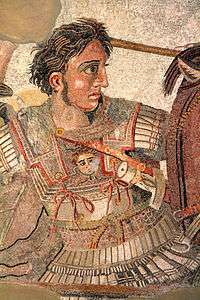
Body armour in the Macedonian army was derived from a repertiore found throughout the Greek-speaking world. The most common form of armour was the linothorax, which was a cuirass of stiff linen built up of glued or stitched layers of textile. It was composed of the 'girdle' a tubular section, often of four vertical panels, that enclosed the torso. A shoulder-piece was attached to the upper rear section of the girdle, this element was split into two wings which were pulled forward over the top of each shoulder and laced to the chest-section of the girdle. Pteruges, strips of linen or leather, protected the upper arms and hips of the wearer. The linothorax could be reinforced with plate bronze or bronze scale elements. Defences of a similar appearance composed of quilted textile are also described.[47]
Less common, due to its expense, was the muscle cuirass. This was a defence made entirely of plate bronze consisting of a breast and backplate, usually with shoulder pieces, modelled in relief on the form a muscular male torso. This was often given pteruges to extend the area of the body covered.[48]
A complete cuirass of plate iron, decorated with gold and modelled on the form of the linothorax, was discovered in the Macedonian royal burial at Vergina. This, alongside the evidence of the depiction of Alexander the Great in the Alexander Mosaic, shows that the technology to make plate armour in iron existed at this time.[49] It is to be doubted that this type of armour was worn by persons other than of royal or very exalted rank.
All of the above forms of armour could be described as thorakes (plural of thorax). Other forms of armour are mentioned in original sources, such as the kotthybos and a type of "half-armour" the hemithorakion (ἡμιθωράκιον); the precise nature of these defences is not known but it would be reasonable to conclude that they were lighter and perhaps afforded less protection than the thorax.[50]
Archaeological remains exist for only one type of limb armour: bronze greaves, which protected the lower leg. Greaves could be worn by both heavy infantry and heavy cavalry, but they are not in great evidence in contemporary depictions. However, greaves are mentioned in the Military Decree of Amphipolis and a pair of greaves, one shorter than the other, were found in the Vergina Tomb.[51]
Xenophon mentions a type of armour called "the hand" to protect the left, bridle, arm of heavy cavalrymen, though there is no supporting evidence for its widespread use. It may have resembled the later manica armour used by Roman gladiators and cataphract cavalry.[52]
Macedonian shields
The Macedonian phalangite shield was circular and displayed a slight convexity; its outer surface was faced by a thin bronze sheet. The inner face of the shield was of wood or a multilayered leather construction, with a band for the forearm fixed to the centre of the shield. Plutarch noted that the phalangites (phalanx soldiers) carried a small shield on their shoulder. This probably meant that, as both hands were needed to hold the sarissa, the shield was worn suspended by a shoulder strap and steadied by the left forearm passing through the armband. The left hand would project beyond the rim of the shield to grip the sarissa. Recent reconstructions of the sarissa and phalangite shield showed that the shoulder strap supporting the shield effectively helps to transfer some of the weight of the sarissa from the left arm to the shoulders when the sarissa is held horizontally in its fighting position.[53]

From pictorial sources, it is probable that the Hypaspists, elite members of the infantry, including the Agema of the King's personal foot guard, employed a shield of larger dimensions, the traditional Greek hoplite shield called the hoplon or aspis (ἀσπίς), it is also referred to as the 'Argive shield'. This shield, also circular, was larger than the phalangite shield, it had sheet-bronze facing over a wooden base; it was held with the left forearm passing through a central armband with a hand-grip set just inside the rim. This shield was more much convex than the phalangite shield and had a projecting rim, both features precluding its use with a double handed pike. The style of shield used by cavalry, if any, is less clear; the heavy cavalry of Alexander's time did not employ shields.[54]
Light infantry javelineers would have used a version of the pelte (Ancient Greek: πέλτη) shield, from whence their name, peltast, derived. This was a light shield made of leather-faced wicker. The shield was of Thracian origin and was originally shaped like a crescent, however, by the time of Macedonian greatness many depictions of peltai show them as being oval or round.[55]
Siege warfare
See Polyidus of Thessaly, Diades of Pella
The Macedonians had developed their siege tactics under Philip. They had for the first time conducted successful sieges against strongly held and fortified positions. This was a dramatic shift from earlier warfare, where Greek armies had lacked the ability to conduct an effective assault. For instance, during the Peloponnesian War, the Spartans were never able to take Athens despite easily conquering her surrounding territory.
Artillery
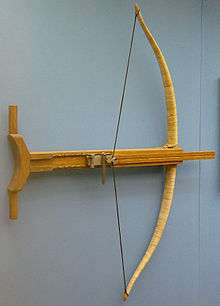
The dramatic change in the abilities of Greeks to operate against fortifications owed much to the development of effective artillery. This had begun around 400 BC in Syracuse under Dionysius I. By Alexander’s time, torsion-powered artillery was in use. Torsion machines used skeins of sinew or hair rope, which were wound around a frame and twisted so as to power two bow arms; these could develop much greater force than earlier forms (such as the gastraphetes) reliant on the elastic properties of a bow-stave. Two forms of such ballista were used by the Macedonians: a smaller bolt-shooting type called the oxybeles and a larger stone-throwing machine called the lithobolos. The largest lithoboloi could fire stones up to 80 kg in weight. Such machines could shower the defenders of a city with missiles and create a breach in the walls themselves.[56]
Alexander the Great appears to have been one of the first generals to employ artillery on the open field of battle, rather than in a siege. He used massed artillery to fire across a river at a Scythian army, causing it to vacate the opposite river bank, thus allowing the Macedonian troops to cross and form a bridgehead.[57]
Other siege engines
In conjunction with various forms of artillery, the Macedonians possessed the ability to build an effective array of siege engines. Prominent in a number of sieges, including the epic Siege of Tyre (332 BC), were siege towers; these allowed men to approach and assault the enemy walls without being exposed to potentially withering missile fire. Equally, they meant that more men could be put on the walls in a shorter period of time, as simple ladders constrained the men attacking to moving up in single file, thus making the task of defending the walls far easier. These structures, which were wheeled and several stories high, were covered with wet hide or metal sheathing to protect from missile fire, especially incendiaries, and the largest might be equipped with artillery. The Macedonian army could also deploy various forms of suspended, metal-tipped, rams. Such rams were usually provided with a wheeled, roofed covering to protect their users from missile fire; they were employed to batter down gates or to dislodge masonry from walls and so cause a breach (this latter form was sometimes called a 'drill' rather than a ram).[58]
Battle tactics
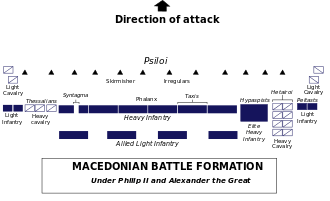
The Macedonian army was one of the first military forces to use 'combined arms tactics', using a variety of specialised troops to fulfill specific battlefield roles in order to form a greater whole.
The tactics used by the Macedonian army throughout the various campaigns it fought were, of course, varied; usually in response to the nature of the enemy forces and their dispositions, and to the physical nature of the battlefield . However, there were a number of features of the tactics employed by the Macedonians in pitched battles which can be identified as being typical. These features were evident in the first major battle the army, newly trained up by Philip, fought in 358 BC and could still be discerned at Gaugamela in 331 BC.[59]
The battle fought in 358 BC near Lake Ohrid was intended to free Macedon of the threat from Illyria and recover some western areas of Macedon from Illyrian control. The Illyrians, led by King Bardylis, were at a similar strength to the Macedonians at about 10-11 thousands. Philip had 600 cavalry, the Illyrians were concerned about being outflanked by the Macedonian cavalry and formed up in a hollow square. Philip massed his cavalry on his right flank and arranged his army in echelon, with the left refused. As had been anticipated, the Illyrians stretched their formation in order to bring the Macedonian left wing into action. Philip waited until the inevitable gap appeared in the left of the Illyrian square, then threw his cavalry at the gap. The cavalry forced their way into the Illyrian ranks and were followed by elements of the phalanx. The Illyrians broke after a fierce struggle, and three-quarters of Bardylis' army were slaughtered. The oblique advance with the left refused, the careful manoeuvring to create disruption in the enemy formation and the knock out charge of the strong right wing, spearheaded by the Companion cavalry, became standard Macedonian practice.[59]
Decline
Following the fragmentation of the empire of Alexander, Macedon became an independent kingdom once again. The military forces of this successor state, the Antigonid Macedonian army, retained many features of the armies of Philip and Alexander. The Hellenistic armies of the other Macedonian successor-states of the Diadochi period, which followed the death of Alexander, also displayed a continuation of earlier Macedonian equipment, organisation and tactics. Towards the end of the period, however, there was a general decline in the use of the combined arms approach, and the phalanx once more became the arm of decision. The phalangites were armed with longer pikes and as a result the phalanx itself became less mobile and adaptable than it had been in Alexander's era.[60] Because all the competing Hellenistic armies were employing the same tactics, these weaknesses were not immediately apparent. However, the Hellenistic armies were eventually faced by forces from outside the successor kingdoms, such as the Roman and Parthian armies, composed of differing troop types using novel tactics. Against such foes the Hellenistic-era phalanx proved vulnerable. The phalanx finally met its end in the Ancient world when the more flexible Roman manipular tactics contributed to the end of Macedon in the 3rd and 2nd centuries B.C.[61]
See also
- Military Decree of Amphipolis
- Antigonid Macedonian army
- List of Macedonian military personnel
- Hellenistic armies
- Seleucid army
- Hoplite
- Pezhetairoi
- Companion cavalry
- Phalanx
- Sarissa
- Xyston
- Wars of Alexander the Great, (Battle of Granicus, Battle of Gaugamela, Battle of Hydaspes)
- Battle of Pydna
- Battle of Cynoscephalae
- Aelianus Tacticus
Notes
- ↑ Connolly, pp. 64-70.
- ↑ Bury, p. 684.
- ↑ Lendon, p. 129.
- ↑ Bury, pp. 685-687.
- ↑ Connolly, pp. 68-69.
- ↑ Diodorus Siculus, Arrian
- ↑ Arrian I.2,,I.12,,II.9
- 1 2 Connolly, p. 71.
- ↑ Ashley, pp. 30-31.
- ↑ Lendon, p. 98.
- ↑ Gaebel, pp. 162-164.
- ↑ Sidnell, p. 84
- ↑ Arrian, Book 6 Ch. 8
- ↑ Sidnell, pp. 96-98
- ↑ Connolly, p. 73.
- ↑ Lendon, pp. 98-101.
- ↑ Ashley. p. 32-33.
- 1 2 Ashley. p. 34.
- ↑ Ashley. p. 35.
- ↑ Curtius, Lacus. "Diodorus Siculus". Retrieved 5/1/14. Check date values in:
|access-date=(help) - ↑ Lendon, p. 11.
- ↑ The Campaigns of Alexander, Arrian, VII.10
- ↑ Ashley, p. 39.
- ↑ Ashley, p. 36.
- ↑ Ellis, J. R., p. 27
- ↑ Ashley, pp. 39-40.
- ↑ Heckel, p 41
- ↑ Ashley, p. 40.
- ↑ Green, p. 290
- ↑ Ashley, p. 45-46.
- ↑ Connolly, pp. 48-49.
- ↑ Sidnell, pp. 57-59
- ↑ Connolly, p. 45.
- ↑ English, pp. 50–51
- ↑ Green, pp. 333-336
- ↑ Connolly, p. 77.
- ↑ Gaebel, p. 164.
- ↑ Sidnell, p.83
- ↑ Ashley, pp. 35-36.
- ↑ Connolly, p. 63
- ↑ Connolly, pp. 48-49
- ↑ Connolly, pp. 70.
- ↑ Anderson, pp. 147- 148.
- ↑ Heckel, p 61
- ↑ Connolly, pp. 72-73.
- ↑ Connolly, p. 63.
- ↑ Connolly, p. 58.
- ↑ Connolly, pp. 54-58.
- ↑ Connolly, pp. 58-59.
- ↑ Connolly, pp. 79-80.
- ↑ Connolly, p. 80
- ↑ Anderson, p. 148.
- ↑ Connolly, p. 79.
- ↑ Connolly. p. 72
- ↑ Dabrowa, p. 145
- ↑ Connolly, pp. 279-282.
- ↑ Cummings, p. 291.
- ↑ Connolly, pp. 280-286
- 1 2 Green, pp. 24-25.
- ↑ Connolly, pp. 80-81
- ↑ Connolly, pp. 140-142, 205-207
References
Primary
- Arrian, Anabasis Alexandri, translated by E.J. Chinnock (1893)
- Diodorus Siculus, Bibliotheca historica (Historical Library) volumes XV - XVIII.
Secondary
- Anderson, J.K, (1961) Ancient Greek Horsemanship, Berkeley and Los Angeles.
- Ashley, J.R. (2004) The Macedonian Empire: The Era of Warfare Under Philip II and Alexander the Great, 359-323 B.C. McFarland.
- Bury, J.B., (1913) A History of Greece to the Death of Alexander. London.
- Connolly, P. (1981) Greece and Rome at War. Macdonald Phoebus, London. ISBN 1-85367-303-X
- Cummings, L.V., (2004) Alexander the Great. Grove Press.
- Dabrowa, E (ed.) (2014) The Greek World in the 4th and 3rd Centuries BC: Electrum Vol. 19, Wydawnictwo. Published by Jagiellonian University, Cracow.
- Ellis, J. R. (1986), Philip II and Macedonian Imperialism. Princeton University Press.
- English, S. (2011) The Army of Alexander the Great, Pen & Sword Military, London.
- Gaebel, R.E, (2004) Cavalry Operations in the Ancient Greek World, University of Oklahoma Press
- Green, P. (1992), Alexander of Macedon: 356–323 B.C. A Historical Biography. University of California Press. ISBN 0-520-07166-2.
- Heckel, W. and Jones, R. (2006) Macedonian Warrior Alexander's elite infantryman, Osprey. ISBN 978-1-84176-950-9
- Lendon, J.E. (2006) Soldiers and Ghosts: A History of Battle in Classical Antiquity, Yale University Press.
- Sekunda N. and McBride, A. (illustrator) (1986) The Ancient Greeks. Osprey Publishing.
- Sidnell, P. (2006) Warhorse: Cavalry in Ancient Warfare, Continuum, London.
Further reading
- Black, ed. by Jeremy (2005). The Seventy Great Battles of All Time. London: Thames & Hudson. ISBN 0500251258.
External links
- Twilight of the Polis and the rise of Macedon (Philip, Demosthenes and the Fall of the Polis). Yale University courses, Lecture 24. (Introduction to Ancient Greek History)

